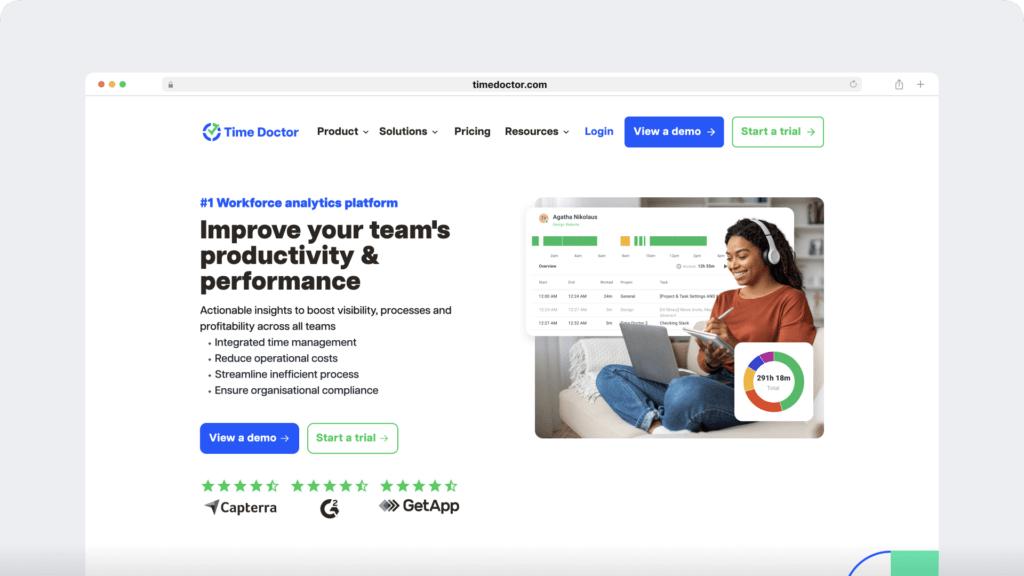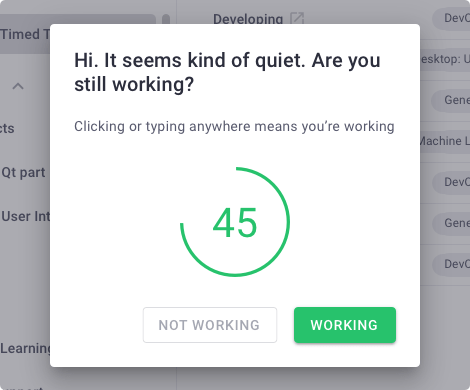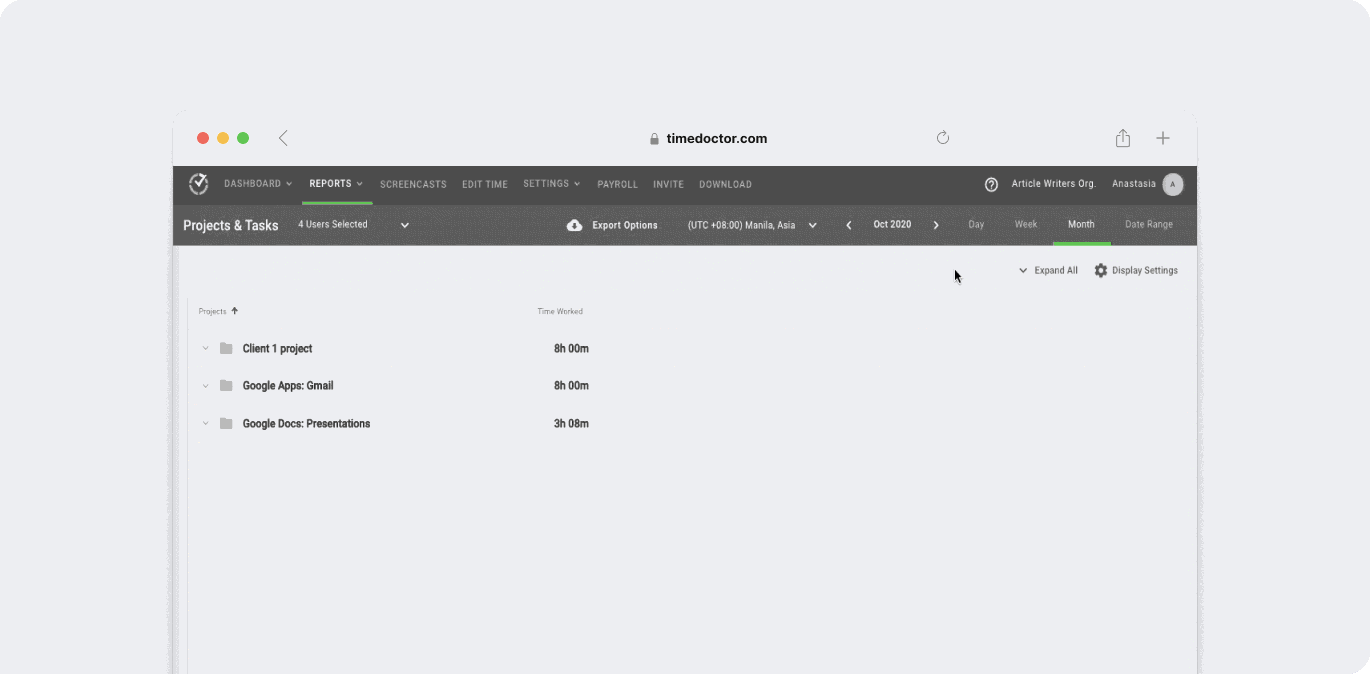Wondering how to increase work efficiency?
If you’re noticing delays in meeting deadlines, failure to reach targets, and reduced creativity, there might be a problem.
All these aspects point to one thing — workplace inefficiency.
It’s time to re-evaluate your team’s efficiency. You’ll have to figure out the root cause of inefficiency and look for foolproof ways to eliminate it.
In this article, we’ll cover the key causes of inefficiencies at work, smart tips to increase efficiency, and the best tool to track efficiency.
Table of Contents
- What is work efficiency?
- 4 key causes of work inefficiency
- 8 smart tips to improve work efficiency
- A tool to help you improve your work efficiency: Time Doctor
- 3 key benefits of better work efficiency
Let’s dive in.
What is work efficiency?
Work efficiency involves using the least amount of resources such as time and effort to produce the highest quality output.
But why should employers track efficiency?
Employers must keep an eye out for efficiency at the workplace to ensure that the team is working at its optimized potential.
An efficient employee would methodically manage their time and effort to tick off the day’s entire task list, with maximum attention to quality.
A business requires high efficiency and increased productivity rates to grow and achieve profitability.
But what is the difference between work efficiency and productivity?
The key difference is quality.
Here’s what we mean:
Producing 100 pens a minute would probably speak highly of your workforce productivity rate. But if half of them don’t write well, it isn’t a mark of high work efficiency.
Ultimately, productivity and efficiency go hand in hand as they measure the ratio of input to output of work. However, efficiency also measures the added element of quality.
4 key causes of work inefficiency
The first step to tackle inefficiency is to dig into its cause.
Here are four typical reasons for workplace inefficiencies:
1. Distractions at work
One of the most common causes of employee inefficiency (especially for a remote employee) is workplace distractions.
Some examples of such distractions include:
- Social media notifications.
- Team members discussing last night’s game.
- Checking emails constantly.
2. Ineffective communication channels
If effective teamwork requires spending excessive time and energy on communication, it means the communication channels are faulty.
Additionally, language barriers decrease efficiency as employees cannot easily explain their perspective to each other. Remote workers who are part of a global team and may not speak the same language often face this issue.
3. Lack of motivation
A major reason for demotivation at work is a poor relationship between employees and their managers.
Unfulfilling work and lack of accountability can also lead to demotivation at the workplace.
When employees are dissatisfied, they’re no longer interested in their work. This means that they won’t spend the time and effort to be as efficient as possible.
4. Burnout
Are your employees finding it tough to cope with their workload?
Chances are, they are facing burnout.
This could be directly affecting your employees’ overall productivity.
Employees might perform poorly on the job and can also face difficulty in their personal lives.
For example, burnout symptoms such as physical fatigue, irritability, or anxiety can take a toll on employees and impact their work effectiveness.
8 smart tips to improve work efficiency
Here are a few ways to increase productivity and efficiency in the team:

1. Encourage a flexible workspace
Allowing flexible work hours can help an employee perform multiple tasks as efficiently as possible.
With a stringent 8-hour workday, a stressed employee is forced to squeeze their exhaustive task list into such a short period of time.
Does this mean the employee is efficient?
Not really.
Strict work hours may ensure that the employee spends less time on a task, but it doesn’t necessarily mean that their work is top-notch quality.
Instead, an efficient employee should get the task done when they are at their productive best.
Flexible work hours also reduces the possibility of burnout and procrastination.
Employers can also encourage flexible arrangements like remote working to increase efficiency, especially during the COVID 19 pandemic.
Apart from eased work hours and implementing a work from home policy, employers can also brainstorm on whether an entirely part-time arrangement might work.
Here’s a detailed guide on how to improve workplace flexibility.
2. Start with the MITs
Ensure that your team separates the MITs from the others on their daily task list.
What are MITs?
MITs refer to the Most Important Tasks, which you must complete by the end of the day.
For example, solving a refund related query of your most important customer can be categorized as a MIT.
An excellent practice would be to indicate the MITs when providing a to-do list to your employees.
Employees can focus on the more significant tasks and then make their way to the smaller tasks that don’t require as much effort — such as administrative tasks like data entry.
By prioritizing work, employees can boost their time management skills and avoid procrastination.
3. Communicate effectively
Have you noticed an email thread with five emails on the same topic when just one email could have done the trick?
The solution to this problem is simple — write better emails and communicate effectively.
Productive employees write informative yet crisp messages, whether on email or Slack.
And if the communication is via a phone call, employees can apply the same concept by taking less time to summarize the key points.
Managers should train teams on how to communicate more efficiently, both internally and externally.
This training can be part of the employee onboarding process as effective communication is an integral part of workplace productivity.
4. Ward off tiring meetings
While communication is essential within the workplace, managers shouldn’t organize frequent, time-consuming meetings.
Instead, employees should use this energy in finishing off critical tasks at hand.
If meetings are unavoidable, encourage standing meetings.
Standing meetings keep the attendees literally on their toes and help keep the energy levels high.
Although the sessions are brief and to the point, they can help increase employee engagement due to minimized distractions, such as mobile device or social media notifications.
5. Steer clear of multitasking
Most people believe that multitasking means high efficiency.
But did you know that multitasking is actually a myth?
Research by multiple psychologists has shown that multitasking ends up hampering your productivity rate — because the human brain wasn’t made to multitask.
Multitasking leads to reduced focus and inefficiency.
In fact, it takes 40% more time to work on a single task while multitasking!
And if there is a demanding and important task at hand, employees should try deep work.
Deep work involves directing one’s entire focus and attention on a single, cognitively demanding job. This requires a great deal of composure, and the effectiveness is truly unmatched.
6. Create a comfortable work environment
Employers often fail to sense overworked employees. That’s why you must support downtime at work.
For example, you could encourage your employees to take a vacation after closing a major deal. Allot those extra sick days in the year, or you can give them an occasional breather if they are working over the weekends.
The bottom line is that a nurturing company culture will keep your employees stimulated to take on work challenges.
7. Work smart with technology
Can you imagine a world without our online calendars sending us meeting reminders?
Technology has already become a necessity to businesses, especially with the increasing popularity of remote work. Companies now have several tools to help them optimize their efficiency and workflow.
For example, a manager based in New York can monitor their Chicago team’s ongoing deals with a project management tool or can get hourly updates through a communication tool.
The manager can also track hundreds of employees’ payment status through a payroll software.
8. Track time spent on a task
How can you distinguish the highly productive people from the rest?
You require concrete data to back this up.
For that, you need a time tracking tool that can tell you how much time an employee spends on a single task in a given day. This will help you pinpoint who’s an efficient employee in your team.
A time tracking tool can help employers answer critical questions such as:
- What are the most productive work hours in my firm?
- Is the time being allotted to the task too much or just adequate?
- Are my employees being productive during work hours or are they idle most of the time?
Read more on the benefits of time tracking.
But what’s the best available tool for productivity management?
A tool to help you improve your work efficiency: Time Doctor
Time Doctor is an employee-friendly productivity management software used by major companies such as Ericsson and small companies like Thrive Market to boost employee productivity and efficiency.

Time Doctor is even more useful for firms with a work from home policy who have limited supervision over their remote team.
Since productivity and efficiency are both vital for any organization to grow exponentially, Time Doctor’s features are the perfect solution to maintain high work efficiency rates.
How Time Doctor helps improves work efficiency
Here’s a quick look at some of Time Doctor’s powerful features:
1. Smooth time tracking
In the manual mode, all it takes is one click and Time Doctor starts recording time.
Once the task is done, the employee can simply click on the stop button for the time tracker to pause.
This way, privacy concerns are taken care of since the employee has full control of the timer.

Note: Time Doctor also offers an automatic time tracking mode for maximum flexibility.
2. Idle time tracking
Wondering whether your employees are actually working, or are they scrolling through Linkedin and social media?
Time Doctor has a built-in inactivity tracker that logs idle time when there is no keyboard or mouse movement on their desktop. This feature nudges employees to focus on the task at hand.

Note: Time Doctor isn’t a keylogger but is a work productivity tracker. To maintain employee privacy, Time Doctor doesn’t monitor which keys are pressed.
3. Detailed productivity reports
Time Doctor’s reports give you a bird’s eye view of each employee’s productivity level.
You can access several reports like:
- Hours tracked: Provides the daily or weekly total number of hours worked.
- Activity summary: Presents the total active time of the employee in the given amount of time.
- Timeline: Offers a comprehensive summary of the time spent by an employee on a task or a project per working day or week.
- Web and app usage: Reports the different websites and applications employees use at work.
- Projects & tasks: Displays how much time an employee has spent working on a specific task or project.

4. Integrations with popular applications
Time Doctor offers smooth integration with 50+ applications used in daily workplace activities such as:
- Project management tools: Trello, Asana
- Customer support: Freshdesk
- Other popular workplace tools: Microsoft 365, Google Apps
These integrations help streamline workflow and boost employee efficiency.

3 key benefits of better work efficiency
You now know how to manage and increase team efficiency.
Let’s now shed some light on the benefits of better work efficiency:
1. Improved client/customer satisfaction
Pleasing the client or customer is no easy job.
Your team must always be on your toes and fulfill every little demand.
With employee work efficiency kicking in, employees can promptly respond quicker to clients and even provide faster delivery of solutions.
2. Reduction of costs
Time is money, as clichéd as that sounds.
For example, as a small business owner, you were about to hire four people for a warehouse job. However, you now find out that two workers are enough for this task due to increased labor productivity. This way, you can cut down on costs.
And how can you get these insights?
Through a productivity management tool like Time Doctor.
By allocating resources optimally and efficiently, your costs automatically decrease over time and lead you on a path to higher profitability.
3. Better work quality
Improved work efficiency also means enhanced quality of work.
When a high performing employee is fully aware and cautious at work, there is relatively little scope for errors. Such work caliber elevates a firm’s credibility, especially if you have a small business.
Wrapping up
Employers need to understand the essence of workplace efficiency and increased productivity.
You can implement the smart tips mentioned above to successfully boost your team’s efficiency and watch your business grow well.
And how can you gauge the current efficiency rate?
Using productivity management software like Time Doctor.
Time Doctor offers several advanced features to monitor and analyze your team’s productivity levels.
Sign up for a free trial and try out Time Doctor today!

Liam Martin is a serial entrepreneur, co-founder of Time Doctor, Staff.com, and the Running Remote Conference, and author of the Wall Street Journal bestseller, “Running Remote.” He advocates for remote work and helps businesses optimize their remote teams.


